The RMS Carpathia Archival Collection: A Legacy of Ocean Travel & Titanic’s Rescue Ship
📌 Explore the RMS Carpathia Archival Collection, featuring passenger lists, menus, sailing schedules, photographs, and historical documents. A valuable resource for historians, genealogists, and maritime enthusiasts tracing transatlantic travel and the Titanic rescue ship’s legacy.

Cunard RMS Carpathia, Length: 540 Feet, Breadth: 64 Feet, Tonnage: 13,603. Famous Cunarders, 1910. GGA Image ID # 1189d25079
Unveiling the Legacy of the RMS Carpathia 🚢✨
The RMS Carpathia Archival Collection is an extraordinary repository of maritime history, offering a comprehensive look into one of the most famous transatlantic liners of the early 20th century. Best known for its heroic rescue of Titanic survivors in 1912, the Carpathia had a rich operational history spanning immigrant voyages, luxury travel, and wartime service before being sunk by a German U-boat in 1918.
This collection serves as a goldmine for educators, genealogists, historians, and ocean travel enthusiasts, as it includes:
✅ Passenger lists detailing travelers across decades, including Titanic-era voyagers
✅ Menus & onboard programs, offering insights into daily life at sea
✅ Photographs & advertisements, capturing the ship’s significance in the golden age of ocean liners
✅ Route maps, logs, and schedules, revealing the paths traveled by thousands of immigrants and elite passengers alike
📌 Through archival documents, rare images, and passenger records, this collection brings to life the era of steamships, transatlantic migration, and historic voyages.
Content Links
- SS Carpathia (1903) Cunard Line Ship's History (Brief)
- Stationery
- Passenger Lists
- Immigrant Documents
- Menus
- Programs
- Brochures
- Sailing Schedules
- Photographs
- Route Maps, Track Charts, Abstract of Logs
- Passage Rates
- Lights and Distances
- Fleet List
- Advertisements
- Books Referencing the RMS Carpathia
- The Cunard SS Carpathia - 1903
SS Carpathia (1903) Cunard Line
Built by Swan, Hunter & Wigham Richardson, Ltd., Wall- send-on-Tyne, England. Tonnage: 13,603. Dimensions: 540' X 64'. Propulsion: Twin-screw, 14 1/2 knots. Masts and Funnels: Four masts and one funnel. Capacity: Had accommodations for 200 second-class and about 1,600 third-class passengers. Titanic Rescue: The Carpathia answered the Titanic's S.O.S. call and succeeded in rescuing a large number of the survivors. Fate: Sunk by three torpedoes on July 17, 1918 when 170 miles from Bishop Rock. The lives of five men in the stokeholds were lost.
Return to Content Links
Stationery

On Board the Cunard RMS Carpathia. Banner from Stationery. GGA Image ID # 1e1a9c1ad2
Return to Content Links
Passenger Lists

📜 Voyage of the SS Carpathia: Prominent Passengers & Their Historic Legacies (1904)
The SS Carpathia, best known for rescuing Titanic survivors in 1912, was already an important transatlantic vessel long before that fateful night. This 1904 passenger list, covering its New York to Liverpool route, provides a snapshot of prominent travelers, including political figures, legal experts, scholars, religious leaders, and artists, making it a goldmine for genealogists, historians, and maritime enthusiasts.
This document is more than just a list of names—it reflects a cross-section of early 20th-century society, showing how ships served as floating bridges between continents, cultures, and professions.
Steamship Line: Cunard Line
Class of Passengers: Cabin
Date of Departure: 4 October 1904
Route: New York to Liverpool
Commander: Captain W. T. Turner
Notable Passengers: Arthur K. Bennett, M.D., A. W. Juncker, Corrie Grant, M.P., William H. Kent, Samuel Dickson, Thomas White Lamb, Count Bethlen Istvan, Rev. E. D. Eshoo, and Rev. Francis Wall.

📖 Voyage to the New World: The SS Carpathia's 1913 Passenger List & Legacy
The SS Carpathia, operated by the Cunard Line, embarked on a transatlantic voyage on 4 November 1913 from Fiume (modern-day Rijeka, Croatia) to New York, stopping at Trieste, Patras, Messina, Naples, Almeria, and Gibraltar. This historic voyage, occurring on the eve of World War I, carried passengers from diverse backgrounds, including prominent figures in academia, the military, religious orders, and business.
The Carpathia was already famous for rescuing survivors of the Titanic in April 1912, making this passenger list an essential artifact for genealogists, historians, and ocean travel enthusiasts.
Steamship Line: Cunard Line
Class of Passengers: Saloon
Date of Departure: 4 November 1913
Route: Fiume to New York via Trieste, Patras, Messina, Naples, Almeria, and Gibraltar
Commander: Captain William Prothero
Notable Passengers: Professor J. B. Esenwein, Dr. J. L. Heard, Colonel C. D. Willcox, Rev. W. L. Groves, Sister M. C. Salvatori, Sister M. G. Napolitano, Sister M. F. Zucchetti, Rev. L. H. Mosier, Mr. F. P. Gutzeit, and Mr. K. Psalidas.
Passenger Récapitulation: Saloon (First-Class): 98, Second Cabin: 190, Third Class: 1,826, Total Passengers: 2,114
Return to Content Links
Immigrant Documents
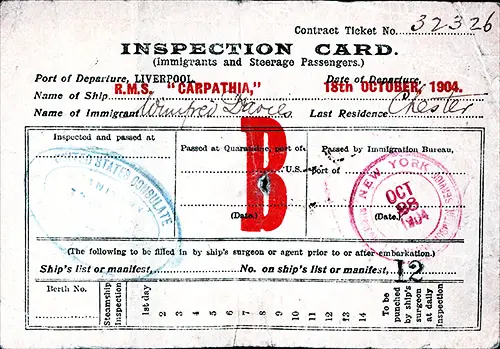
🛂 1904 RMS Carpathia Immigrant Inspection Card – A Rare Document from the Ellis Island Era
The 1904 Immigrant Inspection Card from the RMS Carpathia is an exceptional historical artifact that offers a firsthand glimpse into early 20th-century immigration procedures. Issued to Winifred Davies of Chester, England, this document provides valuable information about her transatlantic journey, health screenings, and arrival process in America.
For teachers, students, genealogists, and historians, this page is a fascinating resource, showcasing the Cunard Line’s role in immigration, public health measures for steerage passengers, and the rigid inspection protocols enforced at Ellis Island.
Return to Content Links
Menus

A Culinary Glimpse into the Past: SS Carpathia’s Second-Class Tea Menu – 6 September 1911
Step aboard the SS Carpathia, where the Second-Class Tea Menu from 6 September 1911 offers a satisfying selection of warm entrees, cold dishes, and classic beverages. This menu provides a blend of hearty, familiar flavors alongside a few surprises that might have puzzled the average American traveler of the era.
Featured Entrées: The Stars of the Menu
Two dishes stand out as the likely featured entrees for the day:
Broiled Salmon Steaks – A premium offering, this dish was likely seasoned simply to let the rich, flaky fish shine. Given the transatlantic route, fresh salmon would have been a luxury item, indicating a focus on quality dining even in second class.
Pork Chops with Paprika – A nod to Eastern European influences, this dish likely featured a mild yet aromatic paprika seasoning, adding depth to the flavor of the seared pork.
For a second-class experience, this menu provided more than just sustenance—it offered a taste of refinement and international flair, ensuring passengers had a memorable dining experience aboard the legendary SS Carpathia.
Thus, while "Tea" in a formal British setting might mean elegant trays of sandwiches and sweets, aboard an ocean liner like the SS Carpathia, it had transformed into a proper meal—one that blended British tradition with the practical needs of hungry transatlantic passengers.
Return to Content Links
Programs

A Grand European Voyage: SS Carpathia’s 1913 Cruise Tour B Souvenir Program
This Tour B Itinerary & Souvenir Program from July 2 – August 23, 1913, offers a rare and engaging look into a grand European cruise aboard the SS Carpathia, just a year after its heroic role in the Titanic rescue. Beyond its historical significance, this document is a treasure trove of insights for educators, students, genealogists, and travel historians, detailing how ocean travel connected cultures and provided luxury experiences in the early 20th century.
Why This Itinerary Matters ✨
This souvenir program isn’t just a schedule—it’s a historical snapshot of how affluent travelers experienced Europe before World War I changed global travel forever. For researchers and history enthusiasts, it offers:
✅ A detailed look at pre-war European travel routes
✅ Cultural and leisure activities of early 20th-century travelers
✅ Valuable information for genealogy research (passenger names & tour details)
✅ An inside look at transatlantic tourism via Cunard Line
Return to Content Links
Brochures

A Fleet of Legends: The 1910 Cunard Line "Famous Cunarders" Booklet
The 1910 "Famous Cunarders" booklet is an exceptional maritime artifact, providing a glimpse into the legendary ships that defined ocean travel in the early 20th century.
Published by the Cunard Line on March 21, 1910, this 8-page booklet serves as both a marketing tool and a historical record, showcasing Cunard’s most famous vessels—including the Lusitania, Mauretania, Carpathia, and Carmania—through detailed specifications and stunning illustrations.
For teachers, students, genealogists, and historians, this document offers:
✅ A firsthand look at Cunard’s premier ships before Titanic’s era
✅ Technical specifications & illustrations of the fleet
✅ Valuable insight into the golden age of transatlantic travel
✅ A research tool for genealogy enthusiasts tracking ancestors who sailed with Cunard
📌 This isn’t just a booklet—it’s a curated collection of some of the most important ocean liners in maritime history.
Return to Content Links
Sailing Schedules

Proposed Sailings, Liverpool-Queenstown (Cobh)-New York, New York-Mediterranean-Adriatic, and Liverpool-Queenstown (Cobh)-Boston, from 20 September 1904 to 3 January 1905. Ships Included the Campania, Carpathia, Etruria, Ivernia, Lucania, Pannonia, Saxonia, Slavonia, Sylvania, Ultonia, and Umbria. SS Carpathia Passenger List, 4 October 1904. GGA Image ID # 1e18ccfaad
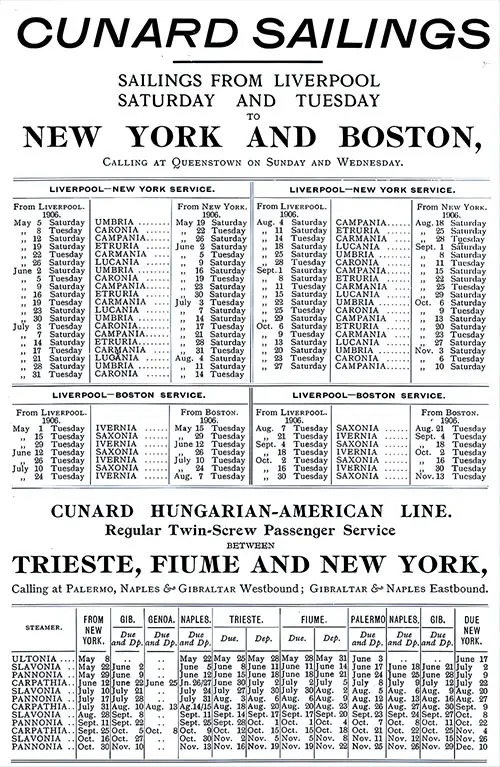
Sailing Schedule, Liverpool to Boston or New York and Trieste-Fiume-New York, from 1 May 1906 to 10 December 1906. Ships Included the Campania, Caronia, Carpathia, Etruria, Ivernia, Lucania, Pannonia, Saxonia, Slavonia, Ultonia, and Umbria. Cunard Daily Bulletin Fashion & Pleasure Resort Supplement, 1906. GGA Image ID # 21581975aa

Sailing Schedule, Liverpool-New York, Liverpool-Boston, and Hungarian-American Service, from 6 June 1908 to 21 November 1908. Ships Included the Campania, Carmania, Caronia, Carpathia, Lucania, Lusitania, Mauretania, Pannonia, Slavonia, Ultonia, and Umbria. Cunard Daily Bulletin, Lusitania Edition, 10 June 1908. GGA Image ID # 1e9f8fdaf1

Sailing Schedule, Liverpool-New York, Liverpool-Boston, New York-Gibraltar-Naples-Trieste-Fiume, Fiume, Palermo-Naples-Gibraltar-New York, from 9 September 1908 to 29 December 1908. Ships Included the Campania, Carmania, Caronia, Carpathia, Etruria, Lucania, Lusitania, Mauretania, Pannonia, Slavonia, Ultonia, and Umbria. Cunard Daily Bulletin, 11 September 1908, Etruria Edition. GGA Image ID # 1f031656fa

Proposed Sailings, Liverpool-Boston Service, Liverpool-New York Service, and Hungarian-American Service Covering 18 May 1909 to 11 September 1909. Ships Include the Campania, Carmania, Caronia, Carpathia, Ivernia, Lucania, Lusitania, Mauretania, Pannonia, Saxonia, Slavonia, and Ultonia. It also contains the Cunard Atlantic Fleet List. RMS Ivernia Passenger List, 18 May 1909. GGA Image ID # 1dc96786d6

Sailing Schedule, Mediterranean-Adriatic Service, from 7 October 1909 to 9 March 1910. Ships Included the Carmania, Caronia, Carpathia, Pannonia, and Ultonia. RMS Mauretania Saloon Passenger List, 6 October 1909. GGA Image ID # 20fab68528

Proposed Sailings, Liverpool-New York Service, Liverpool-Boston Service, and Hugarian-American Service from 23 March 1911. Ships Include the Campania, Carmania, Caronia, Carpathia, Franconia, Ivernia, Lusitania, Mauretania, Pannonia, Saxonia, and Ultonia. RMS Caronia Passenger List, 1 April 1911. GGA Image ID # 1dc9aa5170

Cunard Hungarian-American Service, 1911 to 1912 Sailing Schedule. Ships Include the Pannonia, Carpathia, Saxonia, Ultonia, Franconia, and Caronia. GGA Image ID # 1db734ebb3

Proposed Sailings, Liverpool-New York Service, Liverpool-Boston Service, and Hungarian-American Service from 2 March 1912 to 6 August 1912. Ships Include the Campania, Carmania, Caronia, Carpathia, Franconia, Ivernia, Laconia, Lusitania, Mauretania, Pannonia, and Saxonia. RMS Caronia Passenger List, 30 March 1912. GGA Image ID # 1dc9e8927c

Cunard Hungarian-American Service Sailing Schedule from 2 May 1912 to 16 October 1912. Ships Include the Carpathia, Ivernia, Pannonia, and Saxonia. MEDITERRANEAN CRUISE.—On the 15th February. 1913. the new Twin-Screw Steamer Laconia " will sail from New York to the Mediterranean under charter to Mr. F. C Clark. Full particulars will be announced later. GGA Image ID # 1dbc920ba4

Proposed Sailings Liverpool-New York Service, Liverpool-Boston Service, and Hungarian-American Service from 9 November 1912 to 11 March 1913. Ships Include Campania, Carmania, Caronia, Carpathia, Franconia, Ivernia, Laconia, Lusitania, Mauretania, Pannonia, Saxonia, and Ultonia. SS Carmania Passenger List, 23 November 1912. GGA Image ID # 1dc95f6c98
Return to Content Links
Photographs
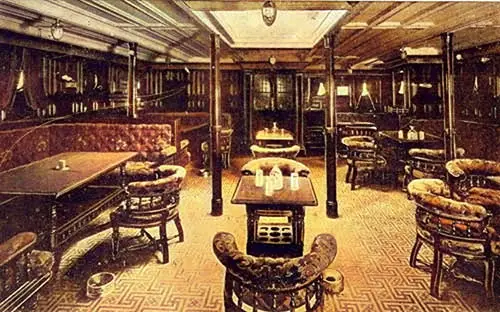
Smoking Room on the RMS Carpathia That Was Used as Sleeping Accommodations for the Titanic Survivors. Cunard Daily Bulletin (1908) p. 70. GGA Image ID # 1030fa8337

Stairway on the Twin Screw Steamship Carpathia. RMS Umbria Cunard Daily Bulletin (25 July 2905) p. 11. GGA Image ID # 106afecf17
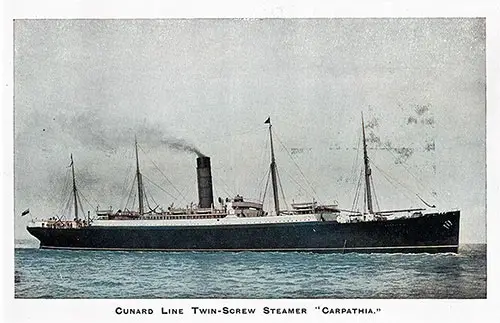
Cunard Line Twin-Screw Steamer RMS Carpathia. RMS Umbria Cunard Daily Bulletin (25 July 2905) p. 11. GGA Image ID # 106bb07df2
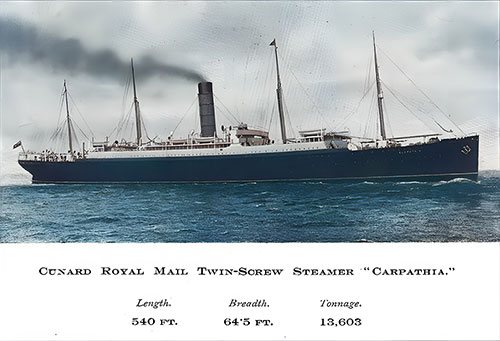
The Cunard Royal Mail Twin-Screw Steamer "Carpathia." Cunard Handbook (May 1905) p. 2. GGA Image ID # 1031a26a51

Captain Rostron of the Carpathia - 1912. © Bain News Service. Library of Congress, Prints and Photographs Division (LC-USZ62-121011). GGA Image ID # 10d65866e7

Captain Rostron and Under Officers of the Carpathia. Photo shows Captain Arthur Henry Rostron next to the silver loving cup presented to him in May 1912 by survivors of the Titanic in recognition of his heroism in their rescue. (Source: Flickr Commons project, 2008) © Bain News Service. Library of Congress, Prints and Photographs Division (LC-DIG-ggbain-10428). GGA Image ID # 10db7fb4e9

The S.S. Carpathia Docked in New York - 1912. © Bain News Service. Library of Congress, Prints and Photographs Division (LC-USZ62-71128). GGA Image ID # 10d59e553b

Rescued Titanic Passengers Aboard the Carpathia: Mr. George A. Harder, Who Was the Only Man Saved of Eleven Honeymoon Couples. Mr. & Mrs. G. A. Harder and Mrs. Charles M. Hayes Talking Whose Husband Was Lost. Library of Congress, Prints and Photographs Division (LC-USZ62-56452), GGA Image ID # 100dc7846f

Groups of Titanic Survivors Aboard Rescue Ship Carpathia: Unidentified Group on Deck. Library of Congress, Prints and Photographs Division (LC-USZ62-56453). GGA Image ID # 100e939fef

Photograph Believed to Be of Passengers on the Carpathia with Survivors from the Titanic. Public Domain Image. GGA Image ID # 10ee41cc53
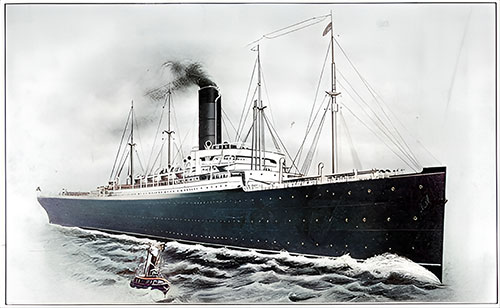
The RMS Carpathia of the Cunard Line - Rescue Ship for the Titanic. The Loss of the S.S. Titanic (1912) p. 00. Underwood & Underwood. GGA Image ID # 106ec461f9

The RMS Carpathia at the Port of Halifax, 1912. GGA Image ID # 1d577df8f4
Return to Content Links
Route Maps, Track Charts, Abstract of Logs
Route Map, Cunard Line SS Carpathia Saloon Passenger List - 4 November 1913. GGA Image ID # 1748bef21f. Click to View Larger Image.
Return to Content Links
Passage Rates

Minimum Rates of Passage, First Class, Second Cabin, or Third Class. Ships Included the Aquitania, Lusitania, Maruetania, Campania, Caronia, Carmania, Franconia, Laconia, Ivernia, Saxonia, Andania, Alaunia, Ascania, Ultonia, Ausonia, Carpathia, and Pannonia. Cunard Line Services 1914 Brochure. GGA Image ID # 1f7949ddf9
Return to Content Links
Lights and Distances

American and British Lights. SS Carpathia Passenger List, 4 October 1904. GGA Image ID # 1e18f2eff0
Return to Content Links
Fleet List

Cunard Line Atlantic Services and Fleet List with Tonnage and Assigned Commanders, 1911. Ships Included the Albania, Aquitania, Ascania, Ausonia, Campania, Carmania, Caronia, Carpathia, Franconia, Ivernia, Laconia, Lusitania, Mauretania, Pannonia, Saxonia, and Ultonia. RMS Franconia Passenger List, 8 August 1911. GGA Image ID # 1e8030fb50

Cunard Line Atlantic Services and Fleet List with Tonnage and Assigned Commanders, 1912. Ships Include the Alaunia, Albania, Andania, Aquitania, Ascania, Ausonia, Campania, Carmania, Caronia, Carpathia, Franconia, Ivernia, Laconia, Lusitania, Mauretania, Pannonia, Saxonia, and Ultonia. RMS Caronia Passenger List, 30 March 1912. GGA Image ID # 1dc9ece700
Return to Content Links
Advertisements

Advertisement for a Mediterranean Cruise on the RMS Carpathia of the Cunard Line. the Carpathia Was Starting out on a Mediterranean Cruise When She Rescued the Titanic Survivors. RMS Umbria Cunard Daily Bulletin (25 July 1905) p. 11. GGA Image ID # 106c197945
Return to Content Links
Books Referencing the RMS Carpathia

A Century of Sea Travel: Personal Accounts from the Steamship Era
This book is a voyage through the life of the passenger steamship, a voyage described by travellers who sailed on these vessels, and it carries within it their thoughts and experiences, mirrored here in words and pictures.

The Cunard Line: A Pictorial History 1840-1990
An Illustrated History of the Cunard Line and the celebrated liners which have served the Fleet, from its Inception in 1840 to the demise of the great transatlantic liners and finally the entry into service of the RMS Queen Elizabeth 2, Britain's last great luxury liner.

Exploring the Mediterranean & Europe: The 1905 Cunard Line Handbook
The Cunard Line Handbook of 1905 is a remarkable maritime and travel artifact, offering a detailed guide for passengers aboard Cunard’s Hungarian-American Line routes from New York to the Mediterranean and Adriatic. This comprehensive travel companion provides extensive descriptions of ports, cultural landmarks, and overland routes, making it an invaluable resource for teachers, students, historians, and genealogists alike.
For those studying transatlantic travel, early tourism, or tracing family migration, this handbook provides:
✅ A look at ocean liner travel before the Titanic era
✅ A guide to Mediterranean and European cities accessible by ship & rail
✅ Detailed maps & plans of key destinations
✅ Information on prominent Cunard liners of the time
📌 More than just a handbook, this is a roadmap to an era when ocean liners were the primary gateway to international travel.

Era of the Passenger Liner - 1992
The Gilded Era comes back to life as the reader relives the careers of stately ships and express greyhounds from immigrant ships to floating palaces. Scarce, large format book containing 288pp. Features photographs, statistics, and background of 280 passenger liners, each with a picture.

The Great Liners: The Seafarers, Volume 4
A history of the world's famous luxury liners provides portraits of the ships. It examines such great disasters as the sinking of the Titanic. This edition explores the grand hotels that traversed the Atlantic between 1840 and 1930.

Great Passenger Ships of the World 1858-1912
This initial volume deals with Ships from 1858-1912, from the first passenger ship of over 10,000 GRT to be placed in service (the Great Eastern) to those unforgettable sister ships, the Olympic and Titanic — the first of more than 40,000 GRT.

Lost Liners, Titanic to the Andrea Doria
Maps, charts, and diagrams make this handsome volume a valuable reference tool and a compelling evocation of that glorious era when floating palaces ruled the sea lanes.

Majesty at Sea: The Four Stackers
The opulent and luxurious four-funnel passenger liners, of which only fourteen have ever been built, are unsurpassed in maritime history. Built between 1897 and 1921, these great vessels vied with each other in their standards of comfort, spaciousness, and speed, and great was the rivalry between their owners.

Passenger Liners of the World Since 1893
The author here takes a nostalgic look back to the heyday of the passenger ship, providing a brief history of 211 ships of over 10,000 tons, together with specifications and technical details of each.
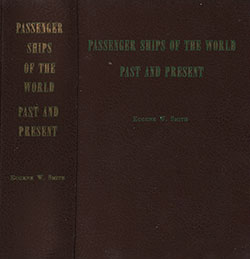
Passenger Ships of the World - 1963
Passenger Ships of the World, 1963, represents an incredible resource covering passenger ships that are Trans-Atlantic, Trans-Pacific, Trans-Pacific via Panama Canal, Latin American, Africa and the Eastern Oceans, and California-Hawaii.

Picture History of British Ocean Liners: 1900 to the Present
Over 200 rare black-and-white illustrations provide views of the ships at sea and in port, glimpses of lavish staterooms, lounges, dining areas, onboard photos of celebrities and royalty, and much more.

Picture History of the Cunard Line 1840 - 1990
The Picture History of the Cunard Line 1840 - 1990 has over 180 photographs and illustrations showing the liners on the high seas and in port and depicting handsome staterooms, lounges, interior decor, and carefree life aboard ship.

Picture History of the Queen Mary and Queen Elizabeth
Powerful and fast Atlantic liners of the 1930s, this volume is packed with high-quality vintage photographs of the RMS Queen Mary and RMS Queen Elizabeth, from construction to heyday to eventual decline and their successor ships bearing the same name.

Sway of the Grand Saloon: A Social History of the North Atlantic
History of the ocean liners of the North Atlantic crossings. A comprehensive history of Trans-Atlantic passenger ships covering 1818 - 1968, with 55 b/w illustrations, photos, and drawings.

The Berengaria Exchange - 1929 Stock Market Crash
This particular trip aboard the Berengaria was to be like no other before or after it, for this was the week when the stock market plunged with the resounding crash that triggered the Great Depression and stripped many of the wealthy on board of everything.

Tramps & Ladies: My Early Years in Steamers
This volume concerns the author's life at sea in tramp steamers and then as an officer of the famous Cunard Line in their fashionable transatlantic service. It culminates with Sir James's experiences of the saving of the survivors from the Titanic in 1912.

Transatlantic and the Great Atlantic Steamships
A stirring narrative of the rapid development of the great transatlantic steamships, from paddle-wheelers to the sleek luxury greyhounds of the modern era -- and the men who designed and ran them.
The Cunard SS Carpathia - 1903

The SS Carpathia in the Mersey after the Voyage. GGA Image ID # 1415a75cff
The latest addition to the Cunard Company’s North Atlantic fleet is the twin-screw steamer Carpathian, whose advent marks a new departure in the history of Atlantic travel.
Before 1850, steamships did not carry steerage passengers. They had to perform the ocean voyage in sailing ships, and the hardships they endured seem incredible in these days of regular, speedy, and luxurious voyaging.
For years after the middle of the last century, the third-class passenger was tolerated rather than catered for on board steamships. He was allotted the least comfortable portions of the ship, and he had none of privacy and seclusion and the very minimum of comfort.
Now, all this has changed, and in recognizing the necessities and desires of those classes of passengers who did not travel in the first saloon, the Cunard Line has, as was only to be expected from the pioneer North Atlantic steamship line, led the way. Needless to say, the enterprise thus manifested has brought its own reward in the shape of world-wide popularity.

The Cunard Liner SS Carpathia. GGA Image ID # 1415c0ae2d
The latest outcome of this consistent effort to provide the maximum accommodation and comfort for second—and third-class passengers is the steamship Carpathian, which carries only these two classes of voyagers. Her builders are Messrs. Swan and Hunter, who achieved such pronounced success with the Cunarder Ivernia.
The Carpathia is one of the largest British vessels, with a gross tonnage of 13,555 tons. A passenger who walks around the ship from bow to bow, vrâ the stern, covers a distance of close to a quarter-mile.
However, her detailed dimensions may give a clearer idea of her great size. These are as follows: length,560 ft.; breadth, 64 ft. 3 in.; depth to upper deck, 40 ft. 6 in.

Passengers on the Deck of the Carpathia Enjoy a Deck Race. GGA Image ID # 1415c7a81e
The ratio of length to the beam is 87, and this relatively great breadth is an important factor in ensuring not only roomy passenger quarters but, what is equally important, steadiness at sea. But she does not rely upon great beam to secure this latter desideratum.
On each bilge of the vessel, that is, on each part of the hull where the side rounds into the bottom, are keels, known, in nautical language, as bilge keels or rolling chocks. These reduce the rolling tendency to a minimum, and thus, with her great size and beam and her side keels, the Carpathia is a phenomenally steady ship.

Another Deck Race on the Carpathia. GGA Image ID # 1415cd7a69
Seagoers frequently complain that some steamers have excessive vibration, the hull pulsating sympathetically to each throb of the engines. On the Carpathia, this vibration is absolutely non-existent. How such a desirable condition has been secured, we do not know.
That is the secret of the designers and builders, but the solid fact remains that vibration is altogether eliminated. As will be seen from our illustration, the Carpathia is a handsome vessel with a graceful hull, one giant funnel, and four raking masts.
The top of the funnel is 130 ft. above the bottom of the ship. To the observer, this will convey some idea of the size of the craft. Still, it also ensures a good draught for the fires in the engine. It carries away all smoke right clear of the ship so that the passengers can enjoy their promenades without any annoying descent of smoke and smuts.

View of the Second Cabin Dining Saloon on the Carpathia. GGA Image ID # 14163b8b55
The Carpathia has four complete steel decks: the lower, main, upper, and shelter decks. Below the lower is the orlop deck, and below that again is the cellular double-bottom, which not only serves the useful purpose of carrying water ballast but prevents the real bottom of the ship from being injured should the vessel be so unfortunate as to run ashore, a contingency which has not yet happened in the long history of the Cunard Line.
Above the shelter deck is the bridge deck, 290 ft. in length, which provides a splendid promenade for passengers, and above that again is the boat deck upon which the boats are carried and offers shelter and shade for the promenades below.
Commencing from the outer shell bottom of the ship, we have the inner bottom, orlop deck, lower, main, upper, shelter bridge, and boat decks. These structures add much to the strength of the vessel. But it is time to speak of the passenger accommodation.

The Third Class Dining Room on the Carpathia. GGA Image ID # 14165b0db6
On the bridge deck amidships is a steel deckhouse that contains a large number of second-class staterooms and a handsome library and writing room in its forward part.
Here are bookcases, writing, occasional tables, lounges, etc., while the decorations and upholstery suggest good taste and solid comfort. Aft of the library is the grand staircase leading to the second—we almost styled it first-class—dining saloon on the deck below.
At the other end of the bridge deck, aft, is a steel deckhouse containing the smoke room, with bars and an en suite lavatory. The smoking saloon is paneled in walnut and handsomely and tastefully furnished and upholstered. The second-class cabins are large and airy and contain two or four beds, a sofa, lavatories, a wardrobe, etc.

A Second Cabin Two-Berthed Room on the Carpathia. GGA Image ID # 141693cd22
The saloon is a handsome apartment extending the entire width of the ship. It can accommodate the full complement of second-class passengers in one sitting.
Nine ports on the port and starboard sides and ten ports forward provide natural light. In addition, there is a central light shaft, the dome of which is tastefully glazed with stained glass. This, with the old gold curtains screening the ports, adds considerably to the appearance of this spacious saloon, which includes handsome sideboards, a piano, etc.
The decorations of the walls and ceiling are in cream and gold, which combine effectively with the rich upholstery and mahogany of the seating accommodation and furniture.

View of the Second Cabin Four-Berthed Cabin on the Carpathia. GGA Image ID # 1416d17d2f
The service rooms adjacent to the saloon are the most up-to-date type, and passengers will appreciate the double entresol, where they may hang their hats or wrap themselves before entering the saloon.
The third might be styled second, with class accommodation on the mainland upper decks. The dining saloon extends the entire width of the ship and will seat over 300 passengers.
The walls are paneled in polished oak with a teak dado, while the seating accommodation is revolving chairs. Add to this that a piano is provided, the floor is covered with linoleum, the tables have white napery, and the dinner and tea services are of handsome design, such as those found in a restaurant ashore. It will be seen how real the effort of the Cunard Company is to cater to the comfort of third-class passengers.

Third Class Smoking Room on the Carpathia. GGA Image ID # 141714b705
The sleeping quarters consist of two and four berth rooms, all done in white enamel, with lavatories, spring mattresses, and bed linen en suite. No rooms contain more than four berths, and no passengers are carried in “open quarters.”
But excellent saloons and sleeping cabins do not exhaust the provision for this class of voyagers. There is a spacious smoking room for men and a sitting room for the opposite sex; there are deck and covered promenades, the latter of which will prove itself a great boon, judging by how similar accommodation on board the Ivernia and Saxonia is appreciated.

View of the Third Class Ladies Sitting Room. GGA Image ID # 141731ea4b
Baths are provided for all classes of passengers, as well as for the seamen, stewards, and Bremen. Nothing is lacking, which the long experience of the Cunard Company can suggest to make passengers as comfortable as possible.
Of course, a barber’s shop is a part of the tout ensemble. The heating and ventilating arrangements of the passenger accommodation are on a specially designed system by which fresh air, the temperature of which can be suited to the weather, is forced through the living rooms at the rate of 25,000 ft. per minute.
This means saloons and staterooms are kept cool in hot weather and warm in cold weather, and the inmates are not subjected to draughts or stuffiness.

View of the Third Class Two-Berthed Room. GGA Image ID # 141733378d
The sanitary arrangements are excellent for both classes of passengers. The vessel is lighted by electricity throughout, and there are about 2,000 lamps in total.
It will be noticed, however, that the staterooms are provided with lamps as an alternative illuminant. Thus, should anything go wrong with the electric light, there is a lamp to hand, ready for lighting.
The precautionary addition to the ship's artificial lighting is in keeping with Cunard's policy of surrounding the passengers with every possible aid to safety and comfort.
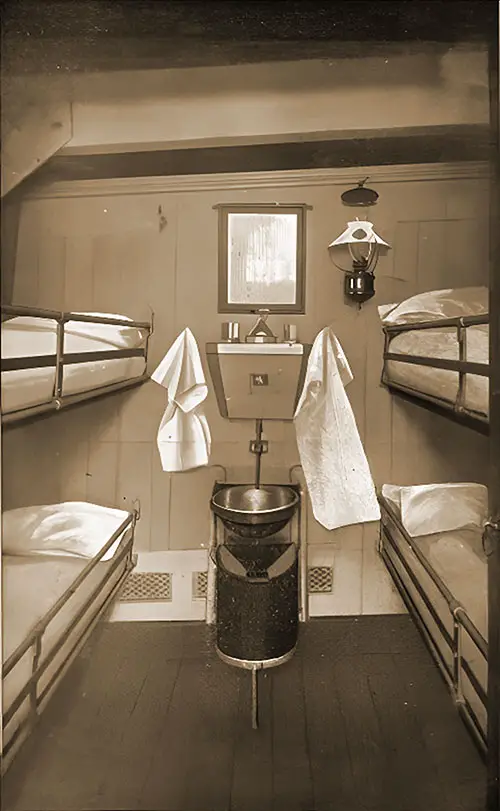
Four-Berthed Third Class Room on the Carpathia. The Syren and Shipping, 6 May 1903. GGA Image ID # 14177223e8
This solicitude of the Cunard Company for the safety of the lives entrusted to them is everywhere apparent. Passengers will notice that the Carpathia carries two masthead lights, one on each of the foremasts, but, of course, at different heights.
By watching these, an approaching vessel can observe any alteration in its course even before the red and green sidelights come within the range of vision. We have already mentioned the double bottom.
Transverse bulkheads divide the ship into distinct watertight compartments. Though two adjoining chambers might be open to the sea, the safety of the ship would not be jeopardized.
There are two sets of engines of the quadruple-expansion type, which have been built by that renowned firm—the Wallsend Slipway and Engineering Company, Limited, which means that the steam is used four times before being returned to the condenser; there are of course,, two shafts and two propellers, so that in case of accident to one engine, shaft, or propeller, the other could bring the vessel to port, and that at a not significantly reduced speed.

Passengers Relaxing on Deck in the Pentland Firtil. GGA Image ID # 1417d71b18
Seen from the deck, the engine rooms appear as a bewildering maze of gratings, iron stairways, steam pipes, levers, and heavy machinery. But when one descends from platform to platform and stands in the engine room, what looks like chaos is the most extraordinary example of order and scientific method.
Even the noise of the whittling machinery doing the work of 9,000 horses is regular and methodical. Far away outside the stern of the ship revolve the propellers, and every revolution they make registers in the engine room, where it can be read at a glance, the unit figure in the index hanging with a rapidity that makes the eye ache.
This automatic recording of the number of revolutions affords a check on the distance the ship is assumed to have traveled and, of course, makes for safety. So does a wonderful contrivance which is part of the engine-room telegraph.
If the officer on the bridge rings to say "full speed astern," an electric gong sounds. Its discordant note will not cease until the order is carried out and the fact is signified to the bridge above. This ensures direct cooperation between the bridge and engine room and eliminates the risk of what is a prevalent cause of accidents.
But the most incredible sight this or any other steamer has to offer is the shafts linking the propellers with the engines. It is a walk of over 200 ft. from the engine room to where the shaft disappears through the aftermost bulkhead. In the tunnel, one can walk upright with a hat on.
A steel bulkhead separates us from the twin shaft on the other side of the ship. Here is the shaft revolving on its well-lubricated bearings, almost noiselessly transmitting the power of 4.500 horses to the propeller revolving in the sea outside.
We are 20 ft. or more under the water here, and the funnel towers over 120 ft. above our heads. Practically, each shaft, from the engine room to the aftermost bulkhead, runs through a hermetically sealed box 200 ft. long. Abaft the engine room is a bulkhead, the water-tight door which would be shut from the engine room if anything went wrong.
But what about the men in the tunnel shaft? What would happen to them in such an emergency? The regard for safety is here again.
Right aft is a steel ladder leading through a manhole to the decks above. Thus, the men attending to the shaft's lubrication could leave the tunnel without passing through the engine room, while at the same time, the closing of the bulkhead door would keep the water out of the engine room.
It may seem somewhat unnecessary to point out this ubiquitous evidence of care and precaution, for the Cunard Line proudly boasts that, though their historic Britannia initiated their mail and passenger business in 1840, no life or letter has been lost from a Cunard vessel during the intervening 62 or 63 years.
This is a marvelous record that tells its own story of staunch ships, competent officers and crews, and management that closely supervises every detail and leaves nothing to chance.
Before the Carpathia sailed on her first voyage on the 5th inst., all her boats were tested to see if they were ready for immediate use. Every member of her crew was drilled on his particular duty in case of emergency. Each officer, sailor, fireman, and steward was assigned to a particular boat and knew the part he would have to play in case of an accident.
Should a fire alarm be raised, pumps, hoses, blankets, and extinguishers would be ready for use, and that by the men instructed in their manipulation. We do not mention this because there is any need to anticipate such necessities but because this all-around vigilance and caution emphasize the wisdom of the Cunard policy of avoiding danger by preparing for it.
And the same care taken to ensure safety characterizes the pains taken to secure the comfort of passengers. The table is liberal, the stewards well trained and ample in number, so that the food and service will win the admiration of each class of voyager just as the "Cunard table" on the other vessels of the North Atlantic fleet, whether first, second or third class, is justly famous for its excellence and variety.
Indeed, we place on that record that it deserves a specimen day's menu for the third-class in this type of Cunarder. If this is so excellent, what of others?:
Breakfast, at 8 o'clock.—
Oatmeal porridge and milk, fried fresh fish, steak and onions, bread and butter, jam or marmalade, tea or coffee.
Dinner, at 1 o'clock. —
Soup, ling fish, mutton hot pot, potatoes and vegetables, rice pudding, bread, pickles. Tea,
at 5 o'clock. —
Stewed apricots, rice, bread and butter, tea, jam, or marmalade.
Supper daily.
Gruel at 8 pm. Chicken broth, beef tea, and jellies were supplied to invalids, and Special milk was provided to infants and invalids. The best quality cabin bread, Scandinavian bread, was provided to third-class passengers.
The bills of fare are varied daily at the discretion of the chief steward. Special attention is paid to supplying extra comforts for women, children, and the sick at such times as are required.
Of course, the Carpathia carries a doctor and has well-appointed surgeries and hospitals where male and female passengers can be treated. Her first voyage is to Boston, after which she will run in conjunction with the Aurania on the Tuesday service of the Cunard Company between Liverpool and New York.
The second cabin fare to Boston, New York, Philadelphia, or Baltimore ranges from £8 upwards, while the third-class rate is £5 15s. The latter fare is a striking example of the high state of economic excellence ocean voyaging has now attained and suggests a contrast with railway travel to the latter's disadvantage.
The distance between New York and Liverpool is 3,240 miles, and the rate is £5 15s. It works out at less than one-half penny per mile, although comfortable lodging and excellent board are included. And now our task of telling the tale of the new Cunarder as a mighty ship—one of a new type—is over.
We leave the reader and voyager to decide how it has been done. With their praise shall we be satisfied! There is but left for us to thank the courtesy of Dr. Benedict W. Ginsburg, unvarying, like his skill, for sundry snap-shots of guests on that charming passage which did so much to give the fine new Tyneside product a well-fitting and hearty send-off on her voyage over the face of the waters.
"The Cunard SS Carpathia," in The Syren and Shipping: A Weekly Illustratede Journal, Vol. XXVII, No. 349, Wednesday, 6 May 1903, p. 250-255.
🚢 The Carpathia’s History: More Than Titanic’s Rescue Ship
Though forever linked to the Titanic disaster, the RMS Carpathia’s contributions to ocean travel were extensive. Built in 1903 and designed to cater primarily to second- and third-class passengers, Carpathia became a lifeline for immigrants traveling from Europe to the United States. This collection documents its role in global migration and luxury travel, making it an essential study for historians and genealogists.
Titanic Rescue – The Carpathia’s most defining moment was responding to Titanic’s S.O.S. distress call on April 15, 1912, saving over 700 survivors. Photographs in the archive show Captain Rostron and crew receiving awards for their heroism.
Wartime Tragedy – The Carpathia’s fate was sealed in 1918, when it was torpedoed by a German U-boat. The loss of five crew members marked the end of an era for one of Cunard’s most historic vessels.
📜 Passenger Lists: Tracing Travelers of the Past
The passenger lists within this collection are some of the most valuable resources for genealogists. These records provide names, nationalities, and travel details, making them a crucial tool for tracing family ancestry.
📖 Highlighted Voyages:
1904 Passenger List (New York to Liverpool) – Includes prominent politicians, scholars, and religious leaders, giving insight into who traveled aboard the Carpathia before it gained worldwide fame.
1913 Passenger List (Fiume to New York) – This list includes a diverse group of immigrants and elite travelers, reflecting the ship’s role in pre-World War I migration.
🔍 Why It Matters: These lists provide direct connections to past travelers, allowing researchers and family historians to uncover personal stories of those who crossed the Atlantic.
🛂 Immigrant Documents: The Ellis Island Connection
A 1904 immigrant inspection card issued aboard the RMS Carpathia offers a rare firsthand look into Ellis Island immigration procedures. The inspection process, health screenings, and documentation provide insight into what early 20th-century immigrants endured when arriving in America.
💡 Why It’s Important:
- Primary source for immigration research
- Evidence of public health measures for steerage passengers
- Links to historical migration trends from Europe to the U.S.
🍽 Menus & Onboard Dining: A Culinary Glimpse into Ocean Travel
The 6 September 1911 Second-Class Tea Menu reveals the quality and variety of meals available aboard the Carpathia. The featured dishes, such as Broiled Salmon Steaks and Pork Chops with Paprika, reflect both British and Eastern European culinary influences, catering to immigrants and tourists alike.
💡 Why It’s Fascinating:
🔹 Provides insight into passenger life and dining customs
🔹 Highlights the contrast between second-class and third-class accommodations
🔹 Shows how ocean liners balanced quality dining with affordability for immigrants
🎭 Concerts & Entertainment at Sea
The 1913 Cruise Tour B Souvenir Program showcases the entertainment and social life aboard the Carpathia, featuring:
- Musical performances
- Comedy sketches
- Literary readings
📌 This provides a vivid snapshot of leisure activities aboard transatlantic voyages, showing how passengers socialized and entertained themselves at sea.
🗺 Route Maps & Sailing Schedules: Following the Carpathia’s Journeys
The collection includes detailed maps, sailing schedules, and track charts, documenting:
🔹 The Carpathia’s major routes between New York, Liverpool, and Mediterranean ports
🔹 How immigrants from Italy, Hungary, and the Adriatic regions traveled to America
🔹 Proposed sailings from 1904–1912, illustrating transatlantic travel patterns
📌 Why This Matters: These records allow historians and genealogists to track migration routes and understand the movement of people before major historical events like World War I.
📷 Noteworthy Images & Their Significance
🔹 Smoking Room Used for Titanic Survivors
A haunting yet historic photo of where rescued passengers found shelter aboard the Carpathia.
🔹 Captain Rostron & Crew
Documents the heroes of the Titanic rescue receiving recognition for their bravery.
🔹 The Carpathia Docked in New York (1912)
A powerful image of the ship’s return from the Titanic rescue mission, greeted by hundreds of anxious onlookers.
🔹 Third-Class Dining Room & Cabins
Offers a rare look at immigrant accommodations, showing the stark contrast between luxury liners and steerage conditions.
🔹 Passengers on Deck During a “Deck Race”
Captures the social and recreational activities of passengers aboard transatlantic journeys.
These photographs help bring the Carpathia’s history to life, giving a visual connection to its passengers and crew.
Who Should Explore This Collection? 🎯
👨🏫 For Teachers & Students:
🔹 A primary source collection for studying transatlantic migration & Titanic history
🔹 An in-depth look at early 20th-century ocean travel & maritime culture
🔹 An engaging way to explore social class differences on ocean liners
📜 For Historians:
🔹 Rare documents and images tracing the Carpathia’s role in major historical events
🔹 Insight into immigration patterns, luxury travel, and maritime innovations
🔹 A detailed case study of ocean liners before WWI
🔍 For Genealogists:
🔹 Passenger lists and immigrant documents for tracing family history
🔹 Route maps and sailing schedules to track ancestors' voyages
🔹 Rare photos and documents linked to Titanic survivors
🚢 For Ocean Travel Enthusiasts:
🔹 A fascinating look at one of Cunard’s most significant ships
🔹 Detailed records of sailing routes, ship design, and onboard life
🔹 An opportunity to explore the evolution of transatlantic travel
Final Thoughts: The RMS Carpathia’s Lasting Impact 🌊🚢
The RMS Carpathia Archival Collection is more than just a historical record—it’s a window into an era of adventure, migration, and heroism at sea. Whether you’re researching family history, studying Titanic’s legacy, or exploring maritime travel, this collection offers an unparalleled glimpse into the past.
Would you have sailed aboard the RMS Carpathia? 🚢✨

